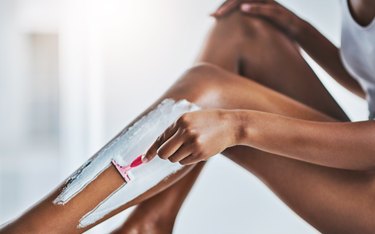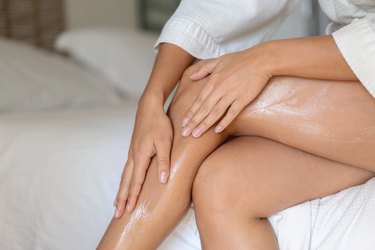
If you choose to banish your body hair, odds are your hair removal involves a razor. Yep, shaving is quick, easy and effective. But there's a major catch to this method: razor burn and razor bumps.
Not only unsightly, these skin issues are also uncomfortable, whether they pop up on your face or your bikini line. But you can usually prevent razor burn and bumps by tweaking your shaving technique.
Video of the Day
Video of the Day
Here, Lucy L. Chen, MD, board-certified dermatologist with Riverchase Dermatology, shares tried-and-true tips and tricks for achieving the smoothest shave possible, plus ways to soothe irritated skin if you're battling razor burn and bumps.
Razor Burn vs. Razor Bumps
While razor burn and razor bumps are commonly used to describe the same thing, they are in fact separate skin conditions. Razor burn usually appears in the form of a tender red rash after shaving, while razor bumps are due to ingrown hairs (i.e., recently trimmed hairs that curl down and grow back into the skin), Dr. Chen explains.
But both types of skin irritation are often caused by incorrect shaving practices. The most common culprits include not using shaving cream or soap, shaving in the opposite direction of your hair, using a dull razor, over-shaving an area or shaving too quickly, Dr. Chen says.
How to Shave Properly to Prevent Razor Burn and Razor Bumps
Whether you're shaving your face, neck, legs, armpits or bikini line, Dr. Chen recommends the following steps for a smooth, seamless shaving experience.
Pre-Shave
- Wet the area with warm water to soften the outer layer of skin (this makes hair removal easier) and apply a lubricant such as shaving cream or gel.
- Choose a sharp razor. A dull blade increases your odds of developing razor burn and bumps.
During the Shave
- Shave in the direction of hair growth, not against it.
- Use short strokes, which allow you to shave precisely and effectively (especially in hard-to-reach areas). "Long strokes, on the other hand, cause the razor to tug at the skin and gather too much hair, which will clog the blade, both of which lead to razor burn or bumps," Dr. Chen says.
- Don't shave over the same area more than once. People often go over the same spot multiple times — especially when shaving the bikini line due to the hair's thickness — but repeatedly shaving the same area often causes razor burn, Dr. Chen says.
- After each stroke, rinse the razor so the blade doesn't get clogged.
After the Shave
- Rinse the skin with cool water after you shave and gently pat the area dry.
- Apply moisturizer to the shaved area to reduce the chances of irritation. Dr. Chen recommends aloe vera for the bikini line.
- Dispose of the razor after five to seven uses, or when the razor appears to be dull or clogged.
Choosing the Right Razor
While proper shaving etiquette is essential to reduce razor burn and bumps, so is using a high-quality razor. Here are the best razors, according to Dr. Chen:
1. Gillette Venus Platinum Extra Smooth Razor
"This razor consists of five blades, which create a smooth and long-lasting shave, and includes a water-activated ribbon of moisture to protect the skin against cuts and nicks," Dr. Chen says. "Additionally, the razor has a pivoting head, which prevents awkward-angle strokes in hard-to-reach areas."
Buy it: Amazon.com; Price: $12.99
2. Gillette SkinGuard
"The Gillette SkinGuard includes bumpers between the two blades, which serve to reduce skin irritation, and it glides smoothly across the skin due to the two moisturizing strips on each end of the razor," Dr. Chen says.
Buy it: Amazon.com; Price: $9.25
How to Treat Razor Burn and Bumps

Despite your best efforts, razor burn and bumps are bound to happen from time to time. Here's how to treat the affected skin to safely soothe the irritation.
Razor Burn
Moisturizing products like aftershave can be helpful in the healing process. Specifically, applying aloe vera is a stellar salve for relieving razor burn, Dr. Chen says. She also recommends coconut oil, which is known to have anti-inflammatory properties.
Lastly, "applying a cool compress to the affected area will help relieve itchiness and irritation," Dr. Chen adds.
Razor Bumps
You might be tempted to perform "tweezer surgery" on razor bumps to remove the hair trapped beneath the skin, but this is a bad idea.
"People should never pick at or dig at ingrown hairs that cause razor bumps," Dr. Chen says. "Not only does this increase irritation and discomfort, but it can also cause a skin infection and create scars."
When it comes to razor bumps, patience is key. "The proper way to treat ingrown hairs is to apply a warm compress and wait for the hair to emerge above the skin," Dr. Chen says. "Once it does, gently use tweezers and slowly pull it."
When to See a Doctor
"If you find that your razor burn or bump has pus or a whitehead, is painful to the touch and is not healing in a reasonable timeframe, there is a chance that the area is infected," Dr. Chen says. "In that case, seeking medical attention would be wise because you may require an antibiotic cream or ointment."
Is this an emergency? If you are experiencing serious medical symptoms, please see the National Library of Medicine’s list of signs you need emergency medical attention or call 911.